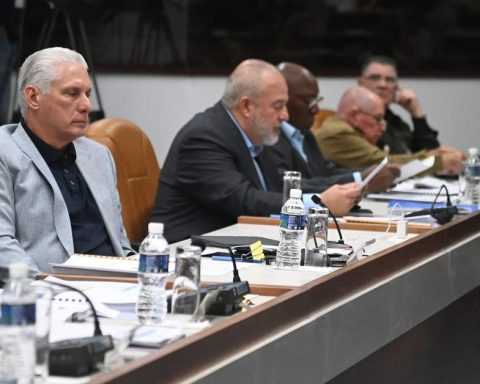The Matanzas Supertanker Base, largely destroyed by the fire that broke out on August 6, was a recently created facility, the product of an agreement signed between Cuba and Venezuela just ten years ago.
The economic support, achieved through the agreements of the Bolivarian Alliance for the Americas (Alba), promoted the storage of hydrocarbons in the port of Matanzas and its industrial zone, located in the bay of that city.
The Super Tanker Base surpasses any other on the Island for its storage capacity for various types of fuel, which exceeds 800,000 cubic meters (800 million liters). Each of the tanks, arranged in two lines of four, keeps a distance of 50 meters from the rest.
According to a material broadcast by Cuban Television, the tanks were assembled from sheets, which in turn formed five superimposed rings. The total height of each tank is 12 meters, while its diameter measures 74. Each one is covered by geodesic aluminum domes, with the aim of reflecting the sun’s rays and reducing the risk of electric shock.
A lightning strike as the cause of the fire in one of the warehouses was, precisely, the official government version, which has not fully clarified the circumstances in which the incident occurred. Nor has it been explained why the tank circuit did not have a cooling mechanism in the walls of the tank to prevent the spread of the fire, or a fire command with more troops.
The Super Tanker Base surpasses any other on the Island due to its storage capacity for various types of fuel.
Some specialists, like Alexandr Goffsteinlifeguard and former head of the Russian Rescuers Preparation Center, have analyzed that “the fact that the fire has spread from one reservoir to others shows that there were defects in the very structure of the base, which led to a disaster of such proportion.”
Gofstein provides specific data that describes the usual protocol in these cases and what behaviors are wrong in the event of such an incident. “On top of such a large fire, a column of very hot air arises, impossible for aircraft to overcome. Extinguishing from a great height, where the air is not so hot, would have no effect, but if the plane goes down, it will simply burn” , explains Russia’s emeritus lifeguard.
Gofstein adds that, against this kind of fire, it is useless to throw water, as the Cuban Air Force has done, and that it is only useful to spread foam, chemical agents and carbon dioxide. He also stated that “when building such oil bases, certain standards must be met”, which Matanzas evidently did not have, such as establishing a “minimum distance between the reservoirs and fencing them off, which prevents fuel spillage.”
“The access roads for firefighters must also be prepared and the so-called ‘dry tubes’ must be installed, not filled with water, intended to cool the tanks in the event of a fire, not to mention guaranteeing safe protection against lightning” , warned the specialist, who believes that “the fire will be extinguished when there is nothing left to burn.”
Nor has it been explained why the tank circuit did not have a cooling mechanism in the walls of the tank to prevent the spread of the fire.
The seriousness of Gofstein’s remarks contrasts with the optimism of the headlines. Granmawho assure that shortly “we are going to recover the Supertanker Base”, or Díaz-Canel’s speech before the Matanzas Command Post: “Today has been the best day, victory generates victory.”
Although the construction of the Super Tanker Base is very recent, the industrial enclave in which it is located was promoted in the 1980s with the help of the former Soviet Union.
An important oil zone already existed in the port since before the Revolution, with the presence of multinationals such as the American Texaco, which owned a dock and several warehouses in Matanzas. These properties were confiscated by the Government, together with different plants of that and other companies, in 1960.
In the port of Matanzas, five docks were also built to receive oil ships and other cargo, although the Government alleges that the US embargo restricts the arrival of ships. The last tanker arrived in Matanzas in June, with 700,000 barrels of fuel oil, coming from Russia.
In addition to the crude it receives from abroad, the fuel extracted from the national territory itself is processed in the industrial zone, particularly from Varadero and the north coast of Western Cuba.
The industrial enclave in which it is located was promoted in the 1980s with the help of the former Soviet Union.
An oil pipeline, projected through alliances with the Soviet Union and paralyzed during the Special Period until 2007, when it was reopened by Venezuela, allows crude to be pumped from Matanzas to the Cienfuegos refinery.
The Antonio Guiteras thermoelectric plant, which entered the National Electric System in 1988, as well as the Cubanitro fertilizer company and the famous textile processing facility known as Rayonera, founded in 1948, are part of the industrial zone facilities. were merged into the Rayonitro company in 1984.
Despite the fact that Cuban Television reports on the agreement between Alba and Havana to carry out the construction of the Super Tanker Base, there is no additional information on the project or details on the company that carried out the construction. In addition, this newspaper confirmed that some websites that offered information on the Base, such as the corresponding entry in the official encyclopedia ecuredhave been removed.
________________________
Collaborate with our work:
The team of 14ymedio is committed to doing serious journalism that reflects the reality of deep Cuba. Thank you for joining us on this long road. We invite you to continue supporting us, but this time becoming a member of our newspaper. Together we can continue transforming journalism in Cuba.


















